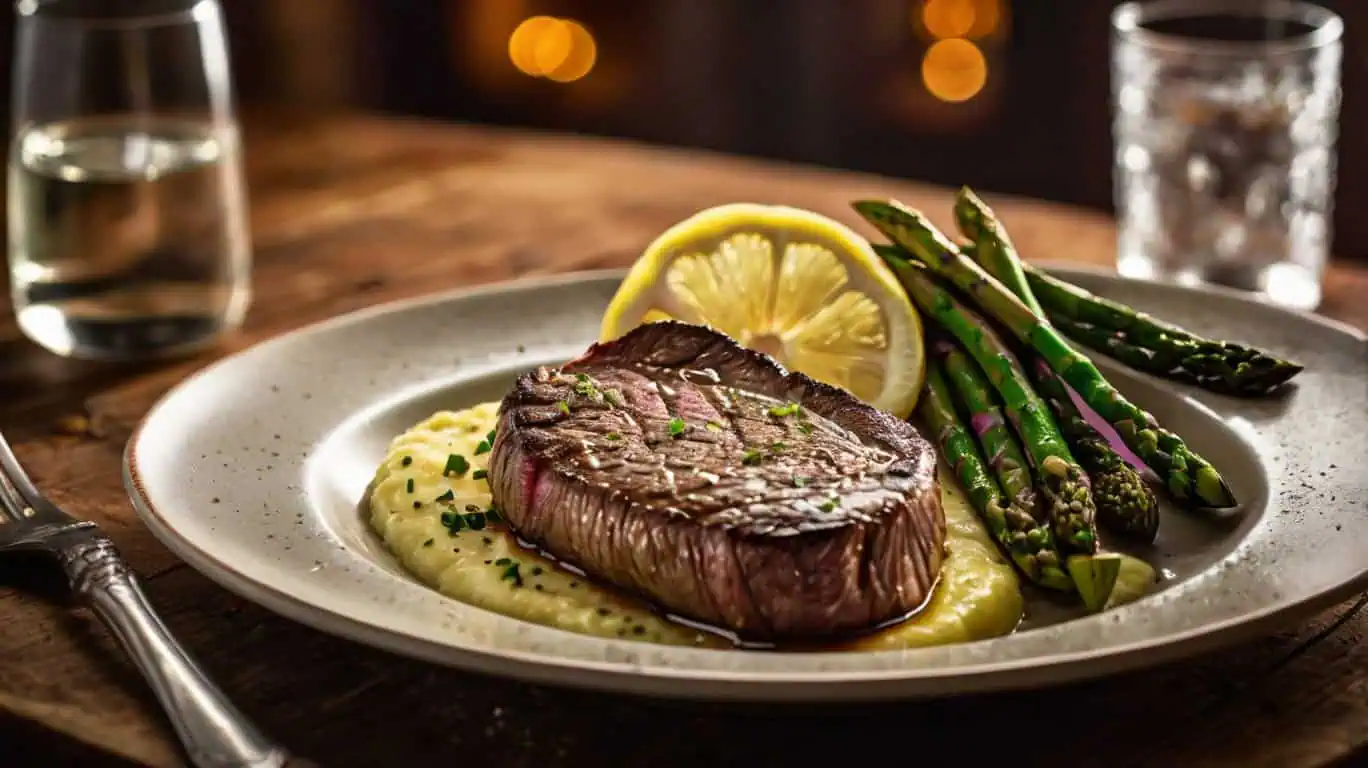Perfect Steak in 30 Minutes: Quick & Juicy
Cooking a perfect steak in 30 minutes that is juicy and flavorful may seem challenging, but it’s simpler than you think.With the right techniques and tools, you can easily transform a basic cut of meat into a restaurant-quality dish. This guide will show you step-by-step how to achieve steak perfection. Whether you’re making dinner for a busy weeknight or preparing a special meal, mastering these methods will elevate your cooking skills effortlessly.
Why the Perfect Steak Matters
A perfectly cooked steak can elevate any meal into something extraordinary. Indeed, the combination of a caramelized crust, tender texture, and rich flavor creates a memorable dining experience. However, achieving this perfection requires careful attention to heat control, seasoning, and timing. Without these essentials, even the best quality meat can turn out disappointing.
For those new to cooking, learning to prepare a steak properly builds confidence. Moreover, for experienced cooks, it’s a skill that always impresses. By mastering the fundamentals, you’ll achieve consistent results whether you’re pan-searing, grilling, or trying sous vide.
To complete your meal, consider pairing your steak with complementary sides. For example, check out our Quick Dinner Recipes for inspiration. Additionally, our Ultimate Guide to Burritos includes ideas for vibrant accompaniments like roasted vegetables or seasoned potatoes.
Furthermore, investing in quality tools will enhance your cooking. A cast iron skillet, for instance, provides even heat for a perfect sear. Similarly, a meat thermometer ensures you reach the ideal level of doneness every time.
In conclusion, cooking steak is more than just preparing food—it’s about creating unforgettable moments. By following these tips, you’ll impress yourself and others with your steak-making skills.
Essential Tools for Steak Perfection
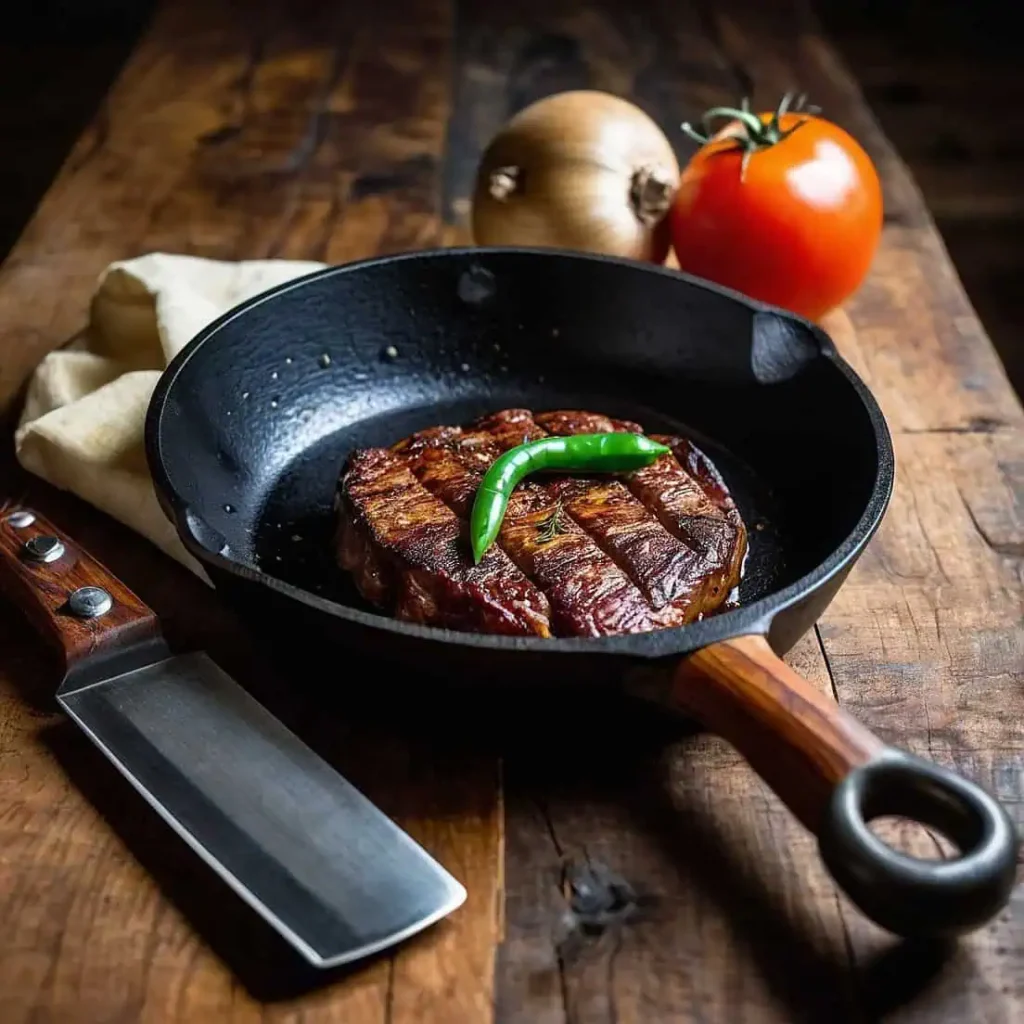
To cook the perfect steak, having the right tools is essential. Not only do they simplify the process, but they also ensure better results. A cast iron skillet is ideal for achieving a great sear because it retains and distributes heat evenly. Unlike other pans, it creates the golden-brown crust that steak lovers crave.
These tools will help you achieve the perfect steak in 30 minutes.
A meat thermometer is another must-have tool. By using one, you can precisely monitor the steak’s internal temperature and avoid overcooking or undercooking. For instance, aim for 130–135°F (54–57°C) for medium-rare or 140–145°F (60–63°C) for medium.
Finally, a sharp chef’s knife is indispensable for trimming excess fat before cooking and slicing the steak afterward. A dull knife can damage the texture of your steak, whereas a sharp one makes clean, effortless cuts.
To complete your setup, consider tools like tongs for easy flipping and a resting rack to maintain the steak’s juiciness. With these tools in hand, you’re well on your way to steak perfection.
To complete your setup, consider tools like tongs for easy flipping and a resting rack to maintain the steak’s juiciness.
With these tools in hand, you’re well on your way to steak perfection.
Selecting the Right Steak
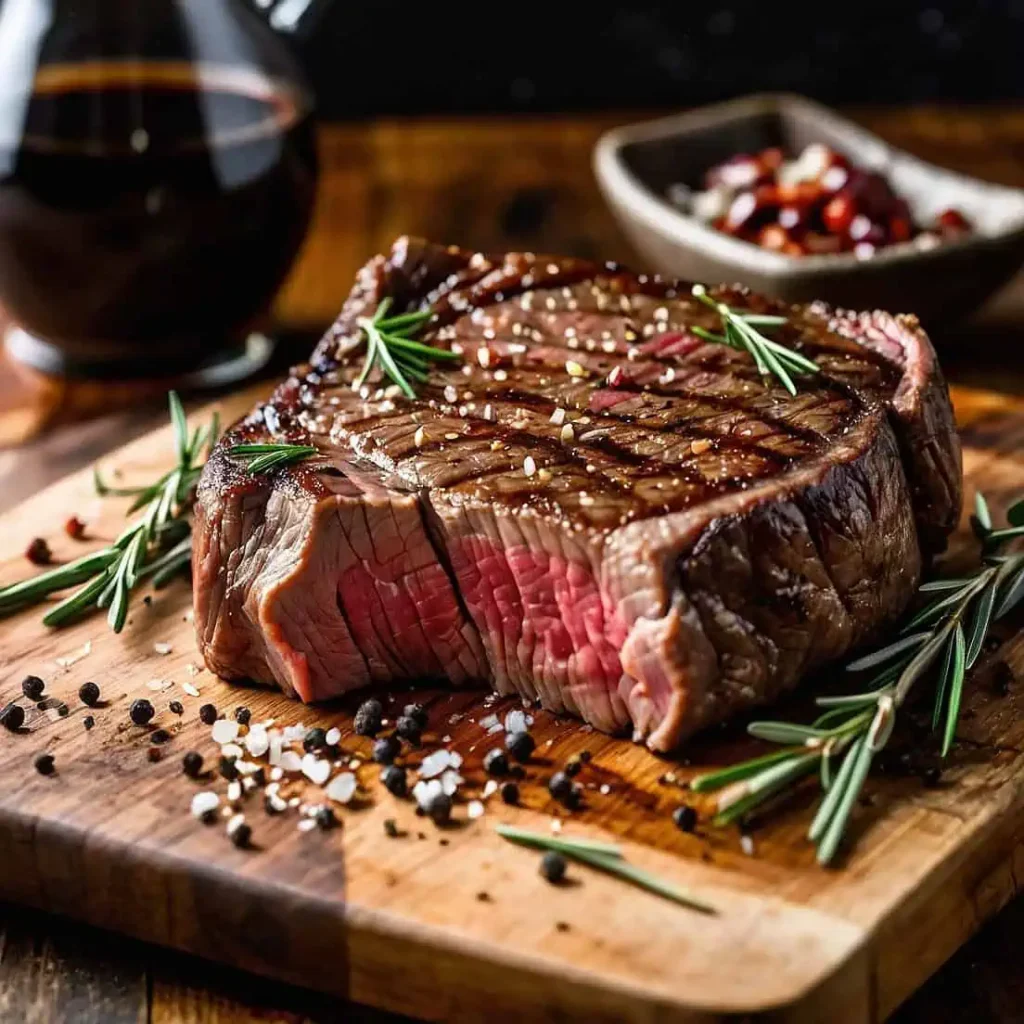
Choosing the right cut is essential for cooking a perfect steak in 30 minutes that is both flavorful and tender.The quality of your steak starts with the cut you choose. Popular options include ribeye, filet mignon, and sirloin, each offering unique textures and flavors. Ribeye is known for its rich marbling, while filet mignon is leaner and tender. Sirloin strikes a balance between flavor and affordability, making it a great choice for beginners.
By choosing the right steak, you’re already on your way to a perfect steak in 30 minutes.
When selecting steak, look for bright red color and visible marbling. Marbling refers to the white streaks of fat running through the meat, which melt during cooking and enhance flavor. Avoid cuts with excessive gristle or discoloration.
For tips on pairing steak with sides, visit Quick Dinner Recipes. High-quality ingredients make all the difference, so choose wisely.
Preparing Your Steak
Proper preparation is key to achieving a perfect steak in 30 minutes.
Prepping your steak properly is key to great results. First, let your steak come to room temperature for even cooking. Cooking straight from the fridge can cause uneven doneness.
Following these preparation steps ensures you’ll enjoy a perfect steak in 30 minutes every time.
Next, season generously with salt and pepper. Salt enhances the meat’s natural flavors, while pepper adds a subtle spice. You can also use garlic powder, rosemary, or other seasonings for extra flavor, depending on your preference.
Trim excess fat if needed, but leave a small layer for added juiciness. After seasoning, let the steak rest for 20–30 minutes to allow the salt to penetrate the meat.
Before cooking, pat the steak dry with a paper towel. This helps create a better sear, giving you that delicious crust. For more tips, check out Essential Cooking Guides. Proper preparation sets the foundation for steak perfection.
The Science of Cooking Steak
Cooking the perfect steak in 30 minutes is as much about science as it is about technique. The key to a flavorful and tender steak lies in understanding the Maillard reaction. This chemical process occurs when the natural sugars and proteins in the meat are exposed to high heat, creating a caramelized crust that adds depth of flavor. Achieving this reaction is crucial for a steak that looks and tastes amazing.
By mastering the science of cooking, you can consistently achieve a perfect steak in 30 minutes.
Equally important is monitoring the internal temperature of your steak. For a medium-rare steak, aim for 130–135°F (54–57°C), while medium is 140–145°F (60–63°C). Using a meat thermometer ensures accuracy, allowing you to avoid overcooking or serving an undercooked steak.
Finally, don’t skip the resting period after cooking. Letting your steak rest for 5–10 minutes allows the juices to redistribute evenly throughout the meat, resulting in a juicy and tender bite. Without this step, you risk losing the flavorful juices when cutting into your steak.
Heat Control and Cooking Methods
The method you choose to cook your steak greatly impacts the final result. Grilling is a popular option, offering smoky flavors and a beautiful char. Keep the heat consistent and avoid flipping the steak too often.
Pan-searing, on the other hand, gives you precise heat control and a perfectly crisp crust. Use a heavy-duty pan, like a cast iron skillet, and preheat it thoroughly before adding the steak.
No matter the method, these techniques ensure you’ll achieve a perfect steak in 30 minutes.
For those seeking precise doneness, sous vide is a foolproof technique. This method involves vacuum-sealing the steak and cooking it in a water bath at a controlled temperature, followed by a quick sear for the perfect finish.
The Perfect Steak Cooking Process
Mastering the cooking process involves attention to detail at every step. Follow these simple instructions for a steak that’s perfectly cooked every time:
Preheating Your Pan
Always preheat your pan before adding the steak. A hot pan ensures the Maillard reaction occurs quickly, creating a flavorful crust. Heat your pan on medium-high for 2–3 minutes until it’s evenly hot.
Preheating your pan properly is the first step to cooking a perfect steak in 30 minutes.
Achieving the Sear
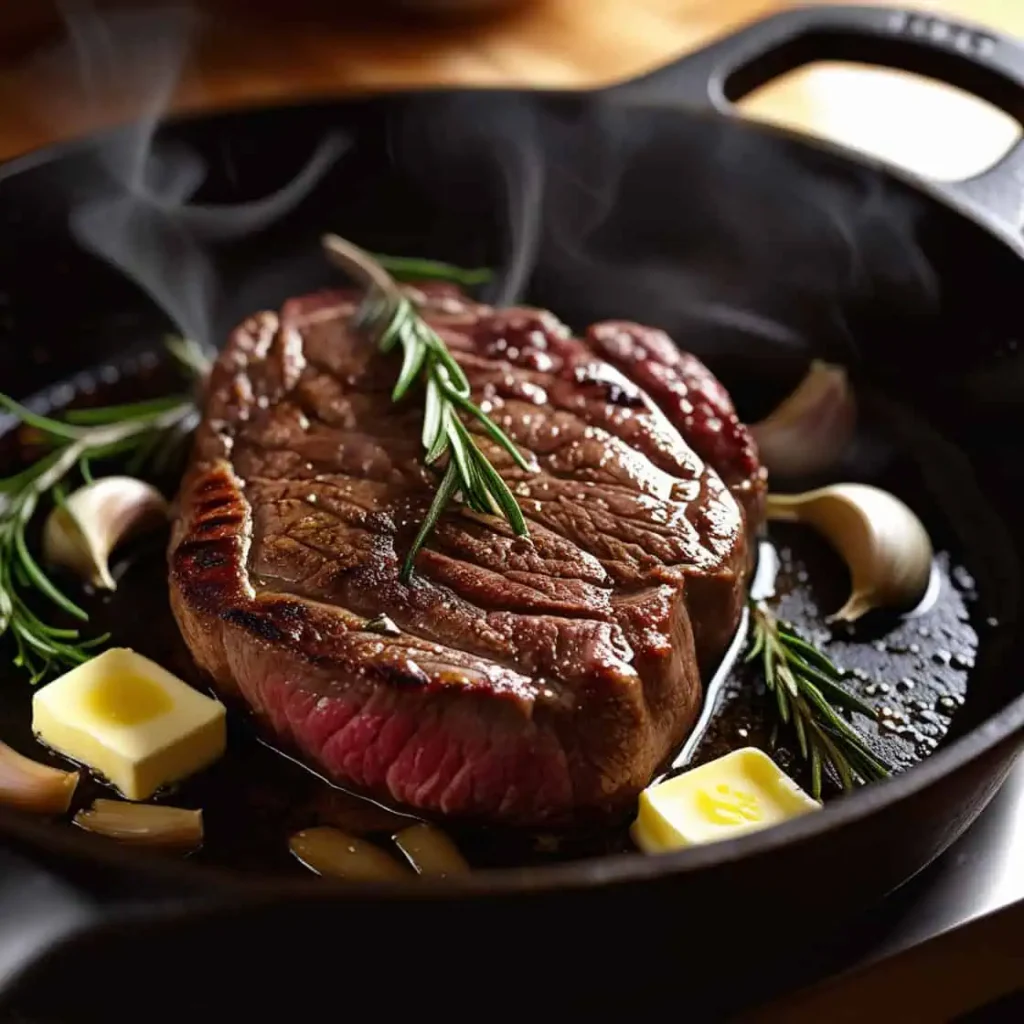
Place the steak in the pan without overcrowding. Let it sear undisturbed for 2–3 minutes on each side to develop a golden-brown crust. Avoid flipping the steak too often, as this disrupts the searing process.
Monitoring Internal Temperature
Use a meat thermometer to check the steak’s doneness. Insert it into the thickest part of the steak for an accurate reading. Remove the steak from heat when it’s 5°F below your desired doneness, as it will continue to cook while resting.
For more tips on steak preparation and sides, explore Quick Dinner Recipes. Following these steps ensures a steak that’s cooked to perfection every time.
Common Steak Cooking Mistakes and How to Avoid Them
Avoid Overcooking for a Perfect Steak in 30 Minutes
Cooking steak may seem straightforward, but small mistakes can make a big difference in the final result. Avoid these common errors to ensure your steak is tender, flavorful, and perfectly cooked every time.
1. Overcooking the Steak
Overcooking is one of the most frequent mistakes, leaving your steak dry and chewy. To prevent this, use a meat thermometer to monitor the internal temperature. For example, remove the steak from the heat at 130–135°F (54–57°C) for medium-rare. Remember that the steak continues to cook slightly during the resting period.
2. Skipping the Resting Period
Cutting into the steak immediately after cooking causes the juices to escape, resulting in dryness. Always rest your steak for 5–10 minutes before slicing. This allows the juices to redistribute, ensuring a moist and flavorful bite.
3. Under-Seasoning the Steak
A common mistake is not seasoning the steak generously enough. Salt not only enhances the flavor but also helps create a crisp crust. For best results, season both sides liberally with salt and pepper before cooking. Adding seasonings like garlic powder or rosemary can elevate the flavor even further.
4. Cooking Cold Steak
Cooking a steak straight from the refrigerator leads to uneven doneness, with the center remaining cold while the outside overcooks. Always let your steak come to room temperature for 20–30 minutes before cooking.
5. Neglecting Heat Control
Using a pan that’s too cool prevents proper searing, while excessively high heat can burn the exterior before the inside cooks. Preheat your pan or grill properly and adjust the heat as needed during cooking.
For more tips on achieving the perfect steak, check out our Ultimate Steak Guide. By avoiding these common mistakes, you can ensure consistent and delicious results every time.
Pairing Your Steak with the Perfect Sides
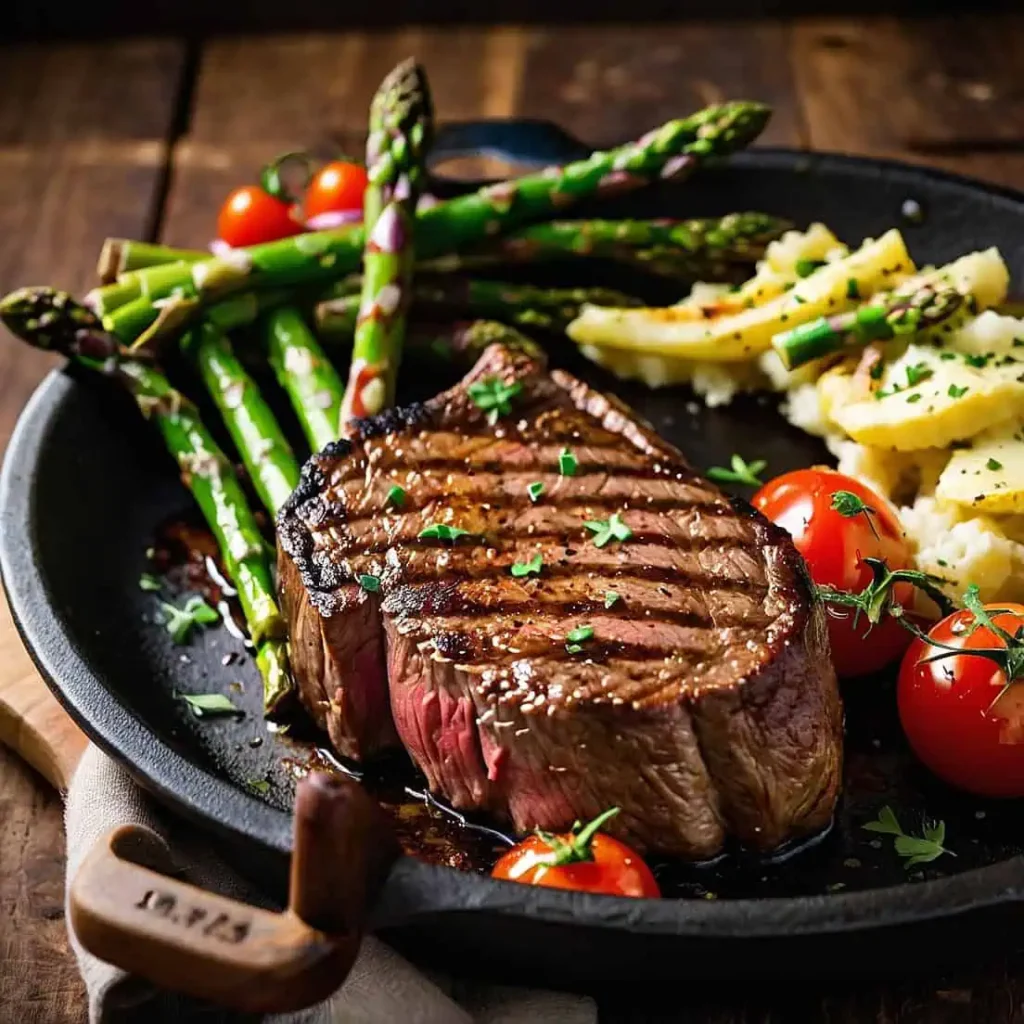
A perfectly cooked steak deserves equally delicious accompaniments to create a balanced and satisfying meal. Choosing the right sides and drinks can elevate your steak dinner to restaurant-quality status. From vegetables to potatoes and flavorful sauces, the right pairings enhance the steak’s rich flavors and create a memorable dining experience.
Pairing the right sides ensures your steak meal is as satisfying as your perfect steak in 30 minutes.
Vegetables, Potatoes, and More
Vegetables and potatoes are classic steak companions that add texture, color, and complementary flavors to your plate.
- Roasted Vegetables: Broccoli, asparagus, or Brussels sprouts roasted with olive oil, garlic, and herbs add a crisp, savory contrast to the rich taste of steak.
- Mashed or Roasted Potatoes: Creamy mashed potatoes with butter and chives provide comfort, while crispy roasted potatoes seasoned with rosemary offer a delightful crunch.
- Salads: A fresh green salad with a tangy vinaigrette can cut through the steak’s richness, creating a refreshing balance.
For more ideas, check out our Quick Dinner Recipes for versatile side dishes that pair perfectly with steak.
Drinks are also essential for rounding out your meal. For non-alcoholic options, sparkling water with citrus or herbal iced teas complement the steak’s savory flavors.
The Role of Sauces
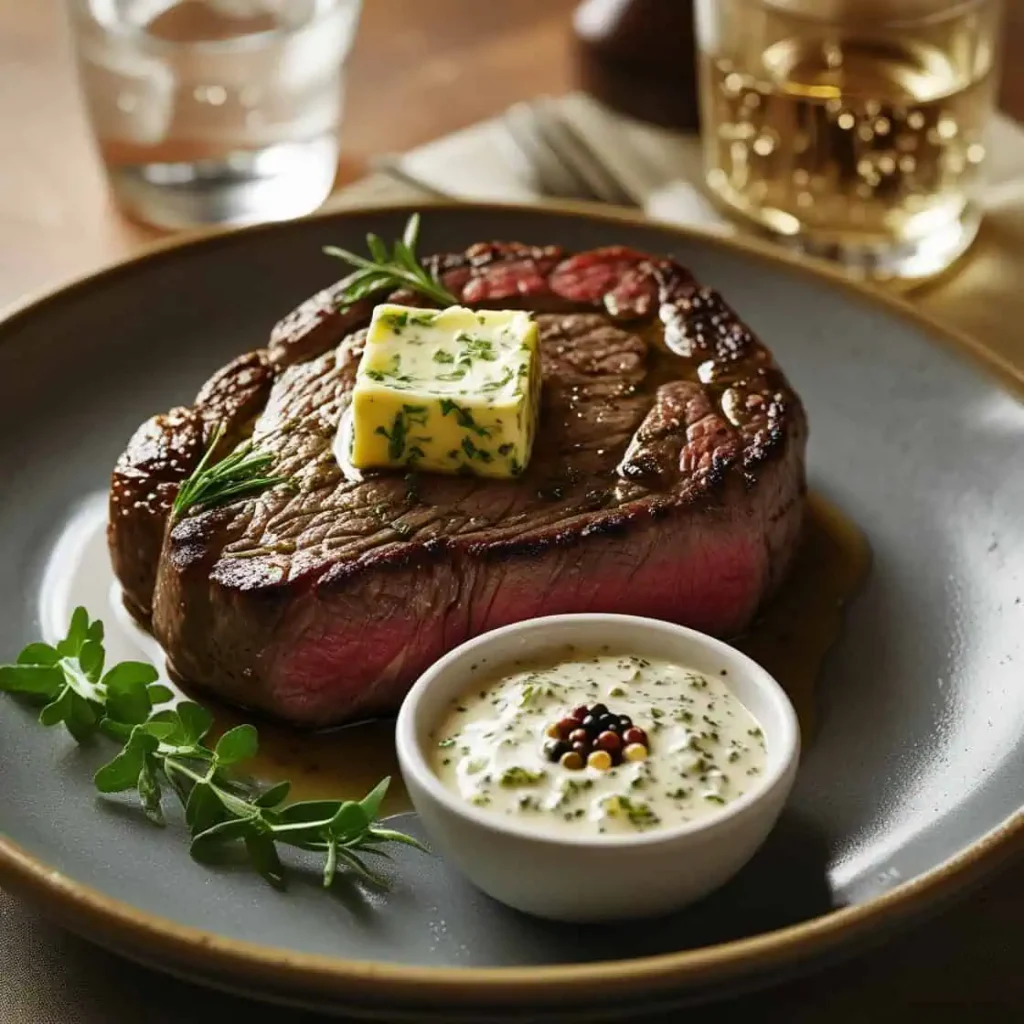
Sauces add another layer of flavor to your steak, enhancing its richness or providing a contrasting element.
- Classic Steak Sauces: Peppercorn sauce, mushroom gravy, or chimichurri are timeless options. These sauces bring bold flavors that complement the meat’s natural juices.
- Butter-Based Sauces: Compound butters infused with garlic, herbs, or blue cheese melt beautifully over a hot steak, adding luxurious creaminess.
- Light Dips: Yogurt-based dips or herb-forward dressings, like a dill sauce, can balance heavier flavors with a fresh touch.
For more inspiration, visit our Guide to Sauces and discover how to match your steak with the perfect topping.
By choosing thoughtful sides and sauces, you can transform a simple steak into a well-rounded, unforgettable meal.
Advanced Tips for the Steak Connoisseur
For those who have mastered the basics of steak cooking, it’s time to take your skills to the next level. These advanced tips will help you refine your technique, experiment with new methods, and achieve even better results. Whether it’s dry-aging your own steak or perfecting your sear, these tricks are designed for steak enthusiasts looking to elevate their craft.
1. Experiment with Dry-Aging
Dry-aging enhances a steak’s flavor and tenderness by allowing natural enzymes to break down the muscle fibers. While professional dry-aging requires specific equipment, you can replicate the process at home with a refrigerator, a wire rack, and plenty of airflow. Leave the steak uncovered for 3–7 days for noticeable flavor development.
2. Perfect the Reverse Sear Method
The reverse sear method is ideal for thicker cuts like ribeye or porterhouse. Start by cooking the steak at a low temperature in the oven or on a grill until it’s just below your desired doneness. Then, finish it with a quick, high-heat sear in a hot skillet to create the perfect crust without overcooking the interior.
3. Use a Basting Technique
Basting adds extra flavor and moisture to your steak. Once the steak is seared on one side, add butter, garlic, and fresh herbs (like thyme or rosemary) to the pan. Tilt the pan and spoon the melted butter over the steak repeatedly, infusing it with rich, aromatic flavors.
4. Rest, Slice, and Serve Perfectly
Let your steak rest for 10–15 minutes for larger cuts to ensure juices redistribute evenly. When slicing, always cut against the grain to make each bite as tender as possible.
For more inspiration and techniques, visit our Expert Cooking Tips. By incorporating these advanced methods, you’ll take your steak game to professional levels.
Frequently Asked Questions
Here are answers to some of the most common questions about cooking the perfect steak.
1. What is the best cut of steak to cook?
The best cut depends on your preference. Ribeye offers rich marbling and flavor, filet mignon is tender and lean, while sirloin provides a good balance of taste and affordability.
2. How long should I let my steak rest before cutting?
Let your steak rest for 5–10 minutes after cooking. This allows the juices to redistribute, ensuring a tender and juicy result.
3. How can I tell when my steak is done?
Use a meat thermometer for accuracy. Medium-rare is 130–135°F (54–57°C), medium is 140–145°F (60–63°C), and well-done is 160°F (71°C) or higher.
4. Should I season my steak before or after cooking?
Season your steak generously with salt and pepper before cooking. This helps the seasoning penetrate the meat and enhances the crust during searing.
5. What’s the best way to achieve a perfect crust?
Use a preheated cast iron skillet for even heat distribution. Pat your steak dry, and avoid overcrowding the pan. Sear each side for 2–3 minutes without moving the steak.
6. Can I cook steak without a thermometer?
Yes, but it’s less precise. Use the finger test: press the steak lightly—soft and spongy indicates rare, while firmer resistance indicates medium to well-done.
For more tips and insights, explore our Complete Steak Guide to refine your skills further.
Conclusion
Cooking the perfect steak in 30 minutes is an art that combines science, skill, and a touch of passion. By following the steps outlined in this guide—from selecting the right cut and mastering heat control to avoiding common mistakes and pairing with the perfect sides—you can achieve steak perfection every time.
With these tips, you can confidently prepare a perfect steak in 30 minutes and impress your guests.
Remember, preparation is key. Use the right tools, such as a cast iron skillet and a meat thermometer, to ensure precise results. Don’t forget to let your steak rest after cooking and always slice against the grain for maximum tenderness. Whether you’re a beginner or an experienced cook, applying these techniques will elevate your steak game to new heights.
Ultimately, cooking steak isn’t just about the meal—it’s about creating moments. Whether it’s a quick dinner for yourself or a special gathering with loved ones, a perfectly cooked steak leaves a lasting impression.
Now it’s your turn to put these tips into action. Practice, experiment, and enjoy the process of becoming a steak master. With a little patience and care, you’ll soon be serving up steaks that rival those from any top-tier restaurant.
For more expert tips and delicious recipes, check out How to Cook the Perfect Steak on Simply Recipes and explore Quick & Easy Steak Recipes on Allrecipes. Get ready to impress your taste buds and your guests—one juicy, perfectly seared steak at a time!

